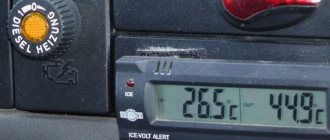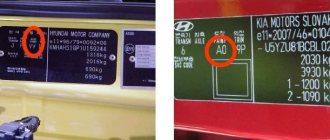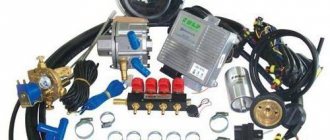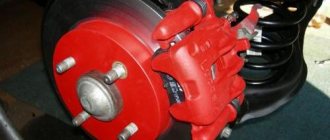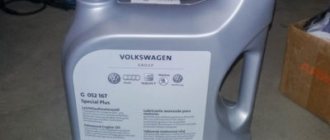4th generation HBO malfunctions
Often, when operating a vehicle on gas, owners do not pay due attention to the maintenance of the gas equipment system. And often the malfunctions of the 4th generation HBO, which are what we will discuss in today’s article, make themselves felt at the most inopportune moment.
The car simply refuses to run on gas, it loses power, the engine stalls, or fuel consumption increases significantly, why does this happen? Most often, experts identify two reasons why 4th generation gas equipment malfunctions occur:
- Maintenance of the gas equipment system was not carried out on time, or was not carried out at all. Remember! Filters on 4th generation gas equipment should be replaced once every 10,000 km, and with the quality of gas at our gas filling stations even more often!
- Wear of system parts over time, increased wear of components can also be influenced by poor quality gas, incorrectly configured ECU or incorrectly adjusted injectors.
Main causes of malfunctions
Below we will highlight the main reasons for the malfunction of the 4th generation LPG, which are quite common, but first of all, before looking for the reasons in the gas installation, you should make sure that the car runs stably on gasoline.
The reasons for unstable LPG operation are not always related to gas; first, pay attention to such vehicle components as spark plugs and high-voltage wires. Quite often, these elements influence incorrect operation and lead to the fact that a car equipped with a 4th generation gas system stalls or loses power.
Engine speed fluctuates on HBO
There are several reasons why the engine does not idle when running on LPG:
- The first thing you need to do is eliminate the electrical component (spark plugs and high-voltage wires);
- If you have not changed gas filters for more than 10,000 km, you should replace them.
Pay attention to the article: Do-it-yourself replacement of gas filters with 4th generation gas equipment. The article describes in detail the step-by-step procedure for replacing filters with photo and video materials.
- The third reason may lie in wear, contamination, incorrect calibration, or completely incorrectly selected injectors.
- The cause may also be wear and tear on the evaporator gearbox itself.
We described several more reasons why the speed on HBO 4 fluctuates in this article.
Loss of engine power when operating on LPG
- Problem with gas injectors (contamination, wear). If cleaning the injectors does not help, you will most likely have to use a repair tool. complete set or replace it. It is quite unlikely that the injectors were miscalibrated. This reason may occur after the installation of new parts and after one to two thousand kilometers. In this case, you need to calibrate.
- The evaporator reducer may not warm up well and, as a result, may not produce the pressure required for operation. Be sure to check the coolant level and possible air pockets in the cooling system.
- If an oxygen sensor fails, it can affect the loss of engine power when running on gas. Most likely, if the lambda probe fails, the “Check engine” sign will light up on the instrument panel.
- Air filter.
- Air leaks due to wear of rubber pipes or leaky connections.
- The cause of clogged gas lines seems unlikely, but given the quality of gas at our gas stations, it is also quite possible.
The engine does not switch from gasoline to gas
If a gas car switches to gasoline, or there is no automatic switch to gas at all, there are several reasons:
- Malfunction of the temperature sensor, which is located in the gas reducer.
- Insufficient heating of the gearbox (possible reasons: low level of coolant in the system, air lock, freezing of coolant at low negative air temperatures).
Read more about the problem of not switching from gasoline to gas here.
Excessive gas consumption
In order to understand whether there is excessive gas consumption, you should calculate what consumption is optimal for your car. In the article about gas consumption by Lanos and Sens cars, we described in detail how to calculate the rate of gas consumption in summer and winter.
- Increased gas consumption can be caused by several factors, namely:
- Worn, dirty or incorrectly calibrated gas injectors.
- Clogged or dirty air filter.
- Problems with the gearbox (not warming up enough, physical wear, requires adjustment).
- The oxygen sensor does not work.
Conclusion
We have tried to provide the most comprehensive list, although, of course, the article does not present all 4th generation LPG malfunctions that may occur during vehicle operation. In any case, if you discover unstable operation of the gas equipment, it is best to contact professionals who will help you find and fix the existing problem as soon as possible.
gbo4auto.ru
Step-by-step replacement instructions
Weaknesses and disadvantages of the 8th generation Honda Accord
After selecting and purchasing two filter elements for the LPG system, they need to be installed on the car, for this we will need:
- Octahedron;
- Screwdriver;
- Brush, brush or vacuum cleaner;
- Rags;
- Set of consumables (two filters and two gaskets).
Attention! Replacing LPG gas filters should be done in a well-ventilated area or outside! Do not replace in a closed garage - it may not be safe.
We close the gas supply valve, which is installed on the cylinder. After which the car should be started and left to run on gas until it exhausts the remaining gas mixture in the LPG line and switches to gasoline. After switching to gasoline, press the button again to switch the car to gas to completely exhaust the entire gas mixture in the system.
After the car stalls, open the hood and unscrew the gas reducer cover bolts, most likely you will need an octagon, but depending on the reducer model there may be other options. After you unscrew the first hexagon, a residual release of gas will occur - this is normal!
After unscrewing all 3 fasteners, remove the cover and remove the old gas filter.
Note! Depending on the frequency of replacement and the quality of the gas, the filter may be in quite poor condition. Remove the rubber seal and remove all debris from the container using a brush or vacuum cleaner
Be careful not to get debris in your eyes! It is best to change the rubber seals, but if this is not possible, they should be replaced at least once. Put back the new seal and filter
Remove the rubber seal and remove all debris from the container using a brush or vacuum cleaner. Be careful not to get debris in your eyes! It is best to change the rubber seals, but if this is not possible, they should be replaced at least once. Replace the new seal and filter.
Don't forget to install the second rubber seal!
Close the cover and tighten the bolts.
Tighten the bolts one at a time to prevent the cover from twisting!
Find a fine filter; it is usually a little easier to get to. To replace it, loosen the clamps, tighten the hoses and dismantle the old cleaning element. Remember the location of the arrow on the old element!
Be careful when installing a new filter element! To position the cleaning element in the correct direction, an arrow is drawn on its body. Install the new filter in the same direction as the old one. Tighten the clamps firmly, but don't overdo it!
- After the replacement is completed, open the gas supply valve on the cylinder, but do not start the car yet.
- You should check the tightness of all connections; this can be done using a soap solution. Clean all the elements and start the car.
If a gas leak is detected (bubbling soap mixture), eliminate it; perhaps the cause is loosely tightened bolts; first of all, tighten them, but do not overdo it, so as not to strip the threads. If the tightening does not help, you will have to disassemble the element and check the O-rings and redo everything again.
Replacing the Atiker coarse filter (Atiker)
If the cleaning element is not installed on the gearbox, but is taken out separately, then the replacement procedure is somewhat different, although the technology itself is similar.
- The first step is to shut off the gas supply valve located on the cylinder.
- Unscrew the Atiker cleaning element and the lines that go to it.
Remove the coil and unscrew the bottom nut on the filter to gain access to the paper cleaning element
Replace the filter element and all rubber sealing rings, then reassemble everything in reverse order.
Having installed everything in its place and connected it to the gas main, be sure to wash all connection points and open the gas supply valve on the cylinder. If a gas leak (bubbling) is detected, repair it.
As you can see, replacing gas filters with 4th generation LPG is not such a difficult undertaking; do not drive with filters that have traveled more than 10,000 km, as this has a detrimental effect on the entire LPG system of your car.
Signs of problems with gas equipment on cars and methods for eliminating them
28.10.2018
The number of cars running on gas is growing from year to year. Owners of such machines periodically encounter problems with the system, despite the fact that modern equipment (of the fourth and subsequent generations) has become much more reliable and safer.
Most problems are not critical, and troubleshooting them yourself won’t hurt your wallet. It is important to detect the first signs of a 4th generation gas equipment malfunction and correctly diagnose the problem.
Causes of malfunctions of car gas equipment
If during the operation of the car unexpectedly deviations from the norm are discovered in any of the indicators, it is necessary to immediately inspect the car. The absence of external signs of breakdown will be the reason for diagnostics using special equipment. Problems occur for the following reasons:
- wear of consumables: filters, seals;
- physical damage to mechanisms and equipment components;
- improper operation of the vehicle;
- refueling with low-quality fuel;
- installation errors (poor quality installation of equipment).
Complete diagnostics can be done on your own if you have some experience or at gas equipment maintenance centers. Using special tools and devices, a specialist will identify the specific reason for the malfunction of the gas equipment.
Important! Some problems cannot be solved on your own if you do not have professional skills and knowledge in this area.
Typical malfunctions on a car with 4th generation gas equipment
Problems with gas equipment are not the most common reason for car repairs; perhaps the malfunction of the vehicle systems is not related to the type of fuel that is currently being used. Correct vehicle diagnosis is the most important step in the process of identifying and eliminating faults.
Malfunctions of 4th generation gas equipment on cars with an injector may not appear immediately. For some time the car may have quite decent characteristics, but at some point changes begin. By ignoring the first warning signs, you can put the entire system at risk of failure. Then replacing the most important parts of the gas equipment will be very expensive. In most cases, costly repairs can be prevented because the most common signs of problems are:
These 4th generation gas equipment malfunctions, as a rule, arise due to untimely maintenance and poor adjustment of mechanisms. Timely contact with a specialist, as well as your own attentiveness, will not only save you from unnecessary expenses, but also guarantee the safety of the car owner and his passengers.
Gas equipment consists of individual parts, the failure of which is characterized by certain problems. It is from them that you can determine the cause of the breakdown, and then how to eliminate it.
GBO componentsRecommendations for diagnosing problems
| Electronic circuit | The most important element of switching and control. Essentially, it is a mini-computer with sensors that respond to any changes in wiring characteristics. The causes can often only be discovered using special software and cables. |
| Fuel filtration system | According to the regulations, it is necessary to change filters every 10,000 km, however, if the quality of the fuel is poor, the need for this operation may occur earlier. |
| Gearbox | Necessary for the evaporation of gas, transforming it from liquid to gaseous state. Poor fuel supply occurs due to insufficient heating of the evaporator and an excessive amount of liquid condensate in the gas. Also aging and wear of the diaphragm. |
| Injectors | If they are incorrectly selected in diameter or clogged with foreign substances, they can significantly reduce engine performance and adversely affect its operation. Injectors most often become the cause of malfunction of the car’s gas equipment: abrupt changes in engine speed, increased fuel consumption. |
| Pipe system, valves, tanks | Damage is caused primarily by external physical influences or aging. Perhaps the locking mechanisms are clogged with dirt, and simply cleaning them is enough to restore functionality. In case of serious damage, parts must be replaced. |
Unlike 4th generation systems, 2nd generation gas system malfunctions on a carburetor engine are sometimes easier to identify and eliminate. Since earlier gas systems had a minimal set of electronic components. HBO 2 for injection engines already has a larger set of electronics, due to the presence of an improved fuel system in such engines. More complex automation causes failure of parts that were not present at all in older equipment releases.
Important! Frequent reasons for calling for service are problems with sensors, switches, and ECU failure.
Troubleshooting methods
Many operations can be performed independently. For example, replace filters, sensors, lines. They have a unified fastening system designed for quick replacement with a minimum of tools required.
However, it is not always possible to eliminate some malfunctions of 4th generation gas equipment on your own. For example, it is better to entrust to a professional master:
It is advisable to consult a specialist when purchasing spare parts and consumables.
But if you have a great desire to repair the car yourself, nothing is impossible. Our website provides up-to-date information on the topic of gas equipment, where everyone can find the answer to their question.
Also, for all problems regarding HBO, ask questions in the form below or by email, we will definitely answer them.
Signs of problems with gas equipment on cars and methods for eliminating them Link to the main publication
gbomotor.ru
Legal nuances of installing gas equipment
Since 2020, the legislation of the Russian Federation has established a procedure for issuing permits and monitoring the installation of gas equipment. In accordance with regulations, a permit is not required for vehicles on which LPG is installed by the manufacturer. In all other cases, permits must be obtained before installing gas equipment in Dzhankoy and Nizhnegorsk .
In addition, maintenance to determine the possibility of installing gas on a car in Crimea . After installation, the car again undergoes examination and registration of gas equipment in the traffic police of Crimea . In general, completing this procedure independently takes about 2 months and costs over 20 thousand rubles, not counting the loss of time and nerves. Moreover, the result will not always be positive.
Illegal installation or repair of gas equipment in Crimea entails a fine of 500 rubles, and then the car is deregistered and sent to a penalty area.
Our specialists will help you go through all stages of installing gas equipment in Dzhankoy and Nizhnegorsk in the shortest possible time and on the most favorable terms.
4th generation HBO malfunctions: symptoms and probable causes
Any mechanisms, even the most advanced ones, are subject to wear and tear, and temporary malfunctions are possible. Installing gas equipment on a car with an injector brings with it a number of difficulties associated with interfering with the standard fuel system. Proper installation and regular maintenance can prevent many problems.
Common 4th generation HBO malfunctions, symptoms and probable causes, as well as methods for troubleshooting problems, are discussed in this article.
Why should problems be fixed immediately?
Gas equipment for injection and carburetor cars, even the best brands, wears out after some time. There are high risks of errors during installation and settings, which ultimately lead to malfunction of the 4th generation gas equipment. Errors during the installation of Tartarini LPG usually appear within the first week of operation.
Failures occur in propane-butane plants and methane-fired plants. When car owners understand gas system problems, issues are resolved faster and cheaper.
The first “bells” appear when filling with gas, when the solenoid valve closes too early and the indicator incorrectly shows the gas level. The operation of the cooling and heating system may be disrupted, the check light is on, the power drops, and if there is gas in the cylinder, the system itself switches to gasoline. The car owner is faced with worn-out injectors, a malfunction of the pressure sensor, gearbox, or a faulty map sensor. Ignoring the “Check Engine” signal leads to burnout of the valve seats.
When converting a car to Euro 4 gas, alpha gas equipment malfunctions largely depend on the professionalism of the technician. Therefore, it is recommended to contact only trusted car services.
Symptoms of malfunctions and solutions
As soon as the first signs of malfunctions of the 4th generation gas equipment appear, you should sound the alarm, find out the cause and carry out repairs. Each brand of HBO has its own weaknesses. For example, a table of faults for the 4th generation alpha LPG helps service technicians in their work.
There are not so many characteristic symptoms of breakdowns, and the solutions are not complicated if you understand the essence of the problem from the beginning.
Gas failures
If you feel dips during sudden gas changes, there may be several reasons:
- clogged gas filter;
- no pressure in the gas reducer;
- map sensor has failed;
- gas injectors are not calibrated correctly;
- the gas pipeline is clogged.
The complexity of the repair depends on what needs to be done. Sometimes there can be several reasons at the same time.
The motor "troits"
The fourth generation LPG of any brand, brc, digitronic, tomasetto, lovato, alpha may malfunction. Possible malfunctions are also reported by 4th generation Tartarini HBO if the settings are incorrect. If, when switching the engine from gasoline to gas, the engine begins to stall, this indicates that the gas system is out of order; it is dangerous to continue operating it without repair.
It is necessary to switch the engine to standard automobile fuel and go to a car service center. It will not be possible to repair it yourself with such symptoms; serious diagnostics are needed.
Antifreeze leak
If a “puddle” appears under the car, the level of antifreeze in the tank has dropped to a critical state and topping up does not help, it is likely that the insertion of the LPG into the cooling system was unsuccessful (the sealing of the joints is broken), or the gearbox is faulty.
It is dangerous for antifreeze to get into the intake manifold, or gas may enter the cooling system. It is necessary to urgently contact a gas installation specialist.
The motor is overheating
When the temperature gauge goes beyond the red line and the coolant boils, this is due to a disruption in the flow of fluid through the system, its airing.
Repair costs at the initial stage are insignificant, it is necessary to remove air pockets, and sometimes replacement of clamps and pipes is required.
The car runs jerkily when switched to gas
An uneven increase in power on gas, the power plant is unstable, and when the vehicle is switched to gasoline, the situation stabilizes and does not always mean a breakdown.
The most harmless thing that can happen is that the gas fuel runs out. A more serious reason lies in the incorrect operation of the injectors. With the second option, you will have to change the set of injectors.
Gas fuel level indicator does not work
What should I do if, with any amount of gas filled, the indicator does not show the actual level?
The sensor, which is responsible for indicating the gas level, may not work correctly if the float is jammed. If there is no serious damage, then with a light tap on the body of the gas cylinder, the float can “come to life”. The second reason is an electrical malfunction. Anything can happen here: from broken wires to a short circuit.
Difficulties when refilling a gas cylinder
Sometimes it is not possible to refill the gas tank, and the gun “bounces” earlier than necessary.
If everything is fine with the equipment at the gas station (and you need to make sure of this), you need to “sin” the solenoid valve of the filling device. Craftsmen usually change it or remove it and clean it. The second option is cheaper.
Car power drops
Symptoms appear gradually. The dynamics of the engine deteriorate over time, although before that everything was fine; the car functions normally on gasoline.
- HBO filters are clogged;
- ECU malfunctions;
- faulty injectors.
The least expensive activity is replacing the filters.
There was a smell of gas
Even with a minor leak, the smell of gas will be felt in the cabin or near the car.
Small leaks may occur at the junctions of gas equipment elements with gas mains. It is also necessary to check the exhaust system.
The check begins with the tightness of the gas pipeline.
The engine stalls
Malfunctions of gas equipment on cars with an injector can appear at the most crucial moment, for example, at an intersection, when the engine suddenly stalls.
Most likely, the culprit is an incorrect setting of the electronic control, or the gearbox is incorrectly mounted.
It is necessary to diagnose the HBO and perform adjustments.
Excessive gas consumption
According to the fuel consumption table, ideally the average gas consumption in liters should be 10-20% higher than gasoline. If the car “eats” 7 liters of gasoline per 100 km. along the highway, gas consumption will be 8-9 liters under the same conditions.
HBO 4th generation - probable causes and symptoms of malfunction
Car parts sooner or later fail, and 4th generation gas equipment cannot last forever if maintenance and diagnostics of the equipment are not carried out on time. In that article we will try to tell you the reasons for breakdowns of the 4th generation gas equipment and the characteristic symptoms of malfunctions.
What causes HBO to malfunction?
— Most often, this is the inattention of motorists who do not delve into its structure and do not perform scheduled maintenance of the gas equipment;
— Poor quality gas, violation of the rules for using a gas cylinder installation and incorrect installation of gas equipment also leads to errors in operation and rapid failure of the gas equipment.
Engine speed fluctuates, uneven engine operation, reasons:
— Compression in the engine is insufficient;
— The spark plugs are faulty;
— Lambda – probe is faulty;
— Gas injection or gas injectors are not adjusted correctly, or the injectors are completely clogged;
Insufficient engine power:
— Incorrect pressure in the gas reducer, poor heating of the gas reducer;
— Lambda – probe is faulty;
— Gas injectors are clogged or not adjusted;
— The gas filter is clogged, the fine gas filter may be clogged;
— Gas lines are clogged.
The engine does not switch from petrol to gas automatically:
— The voltage in the battery is less than 9 volts;
— The signal from the tachometer does not enter the LPG control unit;
— The gas temperature sensor in the reducer is faulty;
Benefits of the service
Our company offers a full range of services for installation and maintenance of gas equipment in Crimea . We work with all types of cars of domestic and foreign production, with gasoline engines of carburetor and injection types.
We offer:
examination of the machine by certified specialists to select the optimal option for installing gas equipment;
assistance in the selection and installation of gas treatment systems from the world's leading manufacturers;
diagnostics of the state of gas treatment in Crimea using modern equipment;
repair of gas equipment for cars in Dzhankoy and Nizhnegorsk ;
reinstallation of the HBO module on a new car at your request.
Effective management and direct supplies of equipment from manufacturers allow us to maintain the most affordable prices for all services for gas equipment for cars . Our technicians regularly undergo advanced training and study the nuances of installing new generation systems in order to guarantee you high quality service and safe, efficient operation of gas equipment.
HBO maintenance
Maintenance and operation of a vehicle with a STAG control system
MAINTENANCE OF THE GASOLINE/GAS SWITCH
Description of the Petrol/Gas switch.
The only element that serves to connect the driver with the STAG control unit is the Petrol/Gas switch.
A) Gas level sensor - Four green LEDs display the gas level in the cylinder. The reserve level is signaled by a glowing red LED, located in a row with green LEDs that indicate the filling level of the cylinders - LED GoFAST, LED-300, in the case of LED-300/401 V, as well as LED-401; the red reserve LED is located under the switch state change button.
B) Signal LED
Operating status for: STAG-200, STAG-4, STAG-300:
- off (gasoline operating mode) - informs that the engine is running on gasoline;
- the LED flashes slowly (once per second - AUTO mode) - the engine starts on gasoline; the control unit waits for the engine temperature;
- blinks normally (2 times per second, no sound signals - AUTO mode) - waiting for revolutions; after reaching the set parameters, the system will automatically switch to LPG power supply;
- the LED flashes quickly (4 times per second, with simultaneous emission of sound signals - emergency mode) - the system has encountered a situation that does not allow the engine to operate on gas; for example, lack of gas in the cylinder, LPG installation error; the engine is powered by gasoline;
- lights up (gas operating mode) - the engine is running on gas.
Operating status for: STAG-4 Q-BOX, STAG 400 DPI, STAG 200 GoFast:
- off (gasoline operating mode) - informs that the engine is running on gasoline;
- the LED flashes slowly (once per second - AUTO mode) - the engine starts on gasoline, and after reaching certain parameters, the system automatically switches to gas power;
- flashes normally (2 times per second, no sound signals - AUTO mode) - the system switches the engine to gas power. This state can last up to 10 seconds, depending on the current engine operating parameters;
- the LED flashes quickly (4 times per second, with simultaneous emission of sound signals - emergency mode) - the system has encountered a situation that does not allow the engine to operate on gas; for example, lack of gas in the cylinder, LPG installation error; the engine is powered by gasoline;
- lights up (gas operating mode) - the engine runs on gases;
- shines red - determination of gas reserve (only for LED-300/401B, as well as LED-4O1).
C) B/G button, AC logo button, GAS button
— selection of the operating mode of the LPG/CNG installation.
Programming the type of fuel.
Control unit in GASOLINE mode:
- turn on the ignition;
- turn on the ignition without starting the engine;
- press the button on the switch until the signaling LED goes out;
- turn off the ignition.
Attention: The engine will only be powered by gasoline.
Control unit in AUTO mode:
- turn on the ignition;
- turn on the ignition without starting the engine;
- press the button on the switch until the signaling LED starts flashing;
- turn off the ignition.
Attention: each subsequent engine ignition will occur in AUTO mode.
H. Information sound signals generated by the switch:
- two short beeps and one long beep (after turning on the ignition) – lack of required technical inspection of the installation;
- three long beeps repeated every minute - the car is ignited in emergency mode (only for STAG-200, STAG-300, STAG-4 Q-BOX).
Signs of complete gas consumption:
— sound — three beeps (short or long, depending on the switch); — blinking green SIGNAL DIODE:
- next to the B/G button (for LED-300),
- next to the GAS button (for LED GoFast);
— blinking white diode under the button — “AC” logo (for LED-300/401B and LED-401).
Note: The gas level indicator displays the current gas level in the cylinder after switching the engine operating mode to gas; Due to the high inertia of the gas in the cylinder, as well as due to the technical capabilities of the measuring system, the diodes indicating a full cylinder may go out disproportionately in relation to the actual state of the gas, and the reserve indication should be considered as indicative.
Emergency engine start on gas
(only for STAG-200, STAG-4, STAG-Z00, STAG-4 Q-BOX, 200 GoFast)
Procedure for STAG-200, STAG-4, STAG-ZOO:
- press the B/O button with the ignition on;
- While holding down the I/O button, start the engine.
Procedure for STAG-4 Q-BOX, 200 GoFast:
- turn on the ignition;
- press the button on the switch and hold for about 3 seconds;
- after the sound signal, release the button;
- start the engine.
NOTE! An emergency start is possible only when the air temperature is positive and the gas equipment is properly installed. After an emergency start, you should wait until the engine temperature reaches the optimal level! Otherwise, the gearbox may freeze and damage the engine!
Automatic calibration of gas level indicator
(only for STAG-200, STAG-4, STAG-300, STAG-4 Q-BOX, 200 GoFast)
Calibration procedure for STAG-200, STAG-4, STAG-300:
- turn on the ignition;
- press and hold the switch button;
- turn off the ignition;
- release the switch button (at this moment the calibration procedure begins, the beginning of which is signaled by a series of triple short blinks of the signaling diode);
- fill a full cylinder of EPO/SMO gas;
- turn on the ignition.
Calibration procedure for STAG-4 Q-BOX, STAG 200 GoFast:
- turn on the ignition;
- press and hold the switch button;
- turn off the ignition within 3 seconds after pressing the button;
- release the button after turning the switch into programming mode (the start of programming is signaled by a repeated smooth increase in the level of the indicator from the minimum to the maximum value);
- fill a full LPG/CNG gas cylinder;
- turn on the ignition.
Indication of calibration status after completion of the procedure:
smooth rise and then fall of the pointer on the LED indicator, from reserve to maximum and back (twice) - calibration has been successfully completed;
changing the level indicator on the LED indicator from reserve to maximum (five times) - failed to complete calibration successfully.
ATTENTION. Calibration should be carried out while filling the gas into an empty cylinder. Upon completion of refueling, turn on the ignition switch, which is equivalent to completing the calibration procedure.
